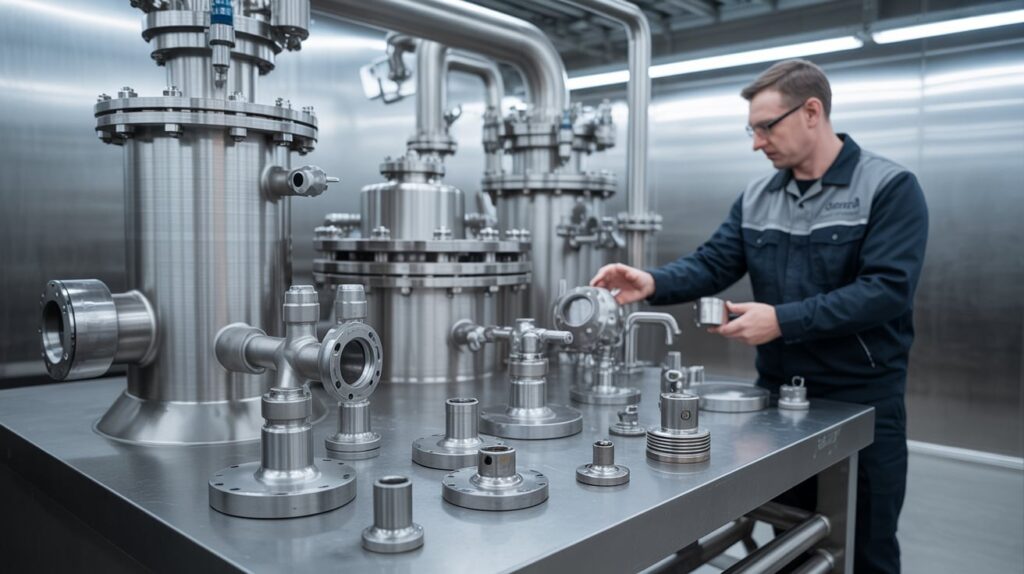Spare parts play a direct role in how well sanitary processing systems perform over time. Each choice affects safety, efficiency, and the overall cost of operation. Knowing what to look for before making a purchase helps maintain smooth production and reduces unnecessary downtime.
Many factors influence the decision, from how well materials handle chemicals and heat to whether parts meet industry standards for sanitation. Availability, durability, and the ability to interchange parts across systems also shape long-term success. By taking these elements into account, companies can protect product quality and keep operations consistent.
Material compatibility with chemicals and thermal conditions
Material compatibility plays a direct role in how long spare parts last in sanitary processing systems. Different chemicals can react with metals, plastics, or seals, which may cause wear, swelling, or corrosion over time. Choosing the right material helps reduce unexpected failures.
Temperature also affects how materials perform. High heat can weaken resistance to chemical attack, while low temperatures may cause brittleness or cracking. Pressure and stress in the system can further influence how materials behave under different conditions.
It is important to match spare parts with the specific chemicals and thermal ranges in the process. For example, a pump seal that works well in water may not perform the same way in acids or solvents. Each application requires careful review before replacement.
Regular maintenance and timely replacement of worn components improve system performance. Access to spare parts and service by CSI Store supports this process by providing parts designed to meet sanitary and chemical requirements.
Compliance with industry sanitary standards
Buyers should confirm that spare parts meet recognized sanitary standards before purchase. These standards define how equipment must be built to allow proper cleaning and reduce the risk of contamination. Parts that fail to meet these requirements may cause safety issues or lead to regulatory problems.
3-A Sanitary Standards are widely used in food and dairy processing. They set clear guidelines for equipment design and materials. A part that carries the 3-A symbol has been reviewed against these requirements by an independent evaluator.
Other industries, such as pharmaceuticals and biotechnology, often follow standards like ASME BPE or ISO 14159. These rules focus on hygienic design, corrosion resistance, and ease of cleaning. Choosing parts that align with the right standard helps maintain compliance across different applications.
Regulatory compliance also supports consistent product quality. By selecting certified parts, companies reduce the chance of contamination and simplify inspections. This approach helps them meet both internal quality goals and external regulatory expectations.
Durability and ease of cleaning
Durability plays a major role in the performance of spare parts for sanitary systems. Parts made from high-quality stainless steel or other corrosion-resistant materials last longer and reduce the need for frequent replacements. This leads to fewer disruptions and lower long-term costs.
Ease of cleaning is equally important in sanitary processing. Surfaces that resist the buildup of residue help maintain hygiene standards and reduce the risk of contamination. Smooth finishes and simple designs allow workers to clean parts quickly and thoroughly.
In addition, durable materials often support easier cleaning because they withstand repeated washdowns without damage. For example, parts that resist rust or wear hold up better under regular sanitation practices. This means the system stays safe and efficient for longer periods.
Therefore, buyers should weigh both durability and cleanability before making a purchase. A part that combines strength with easy maintenance supports consistent operations and helps meet strict sanitary requirements.
Availability of OEM-certified parts
OEM-certified parts often provide consistent quality because they are designed to match the original equipment. This makes them a dependable choice for sanitary processing systems where precision and safety matter. However, their availability can vary by region and supplier.
Some OEM parts may have limited stock, especially for older systems or specialized components. This can lead to longer wait times or higher costs compared to more generic alternatives. Therefore, buyers should confirm lead times before making a purchase decision.
Suppliers that carry OEM-certified parts usually follow strict standards. As a result, the parts tend to meet specific performance and safety requirements. This gives operators more confidence that the replacement will fit and function as intended.
However, businesses should weigh availability against operational needs. If a key system requires fast replacement, limited access to OEM parts could delay maintenance. In such cases, planning ahead and maintaining an inventory of necessary parts can help reduce downtime.
Standardization for interchangeability
Standardization allows spare parts to fit across different equipment models without modification. Parts that follow common standards can replace each other, which reduces delays during maintenance and simplifies sourcing. This practice also avoids confusion caused by multiple part numbers for items that serve the same function.
Interchangeable parts help reduce the total number of unique items that need to be stored. As a result, inventory management becomes more efficient, and storage space is used more effectively. Companies can also lower costs by purchasing fewer variations of the same type of part.
Consistency in parts also supports faster repairs. Technicians can work with familiar components, which shortens downtime and improves accuracy during installation. In regulated industries, using standardized parts also helps maintain compliance with quality and safety requirements.
Therefore, businesses benefit from fewer disruptions, simpler procurement, and more predictable maintenance schedules. Standardization also makes it easier to plan long-term equipment support since compatible parts remain available from multiple suppliers.
Conclusion
Spare parts for sanitary processing systems must meet hygiene standards, fit the equipment correctly, and withstand the conditions of the operation. Poor choices can lead to higher costs, downtime, and product risks.
Quality, compatibility, and availability remain the main factors that guide smart purchasing decisions. Buyers who weigh these points reduce long-term expenses and keep systems running smoothly.
Therefore, careful evaluation before purchase helps businesses maintain safe production, protect product integrity, and support consistent performance.

